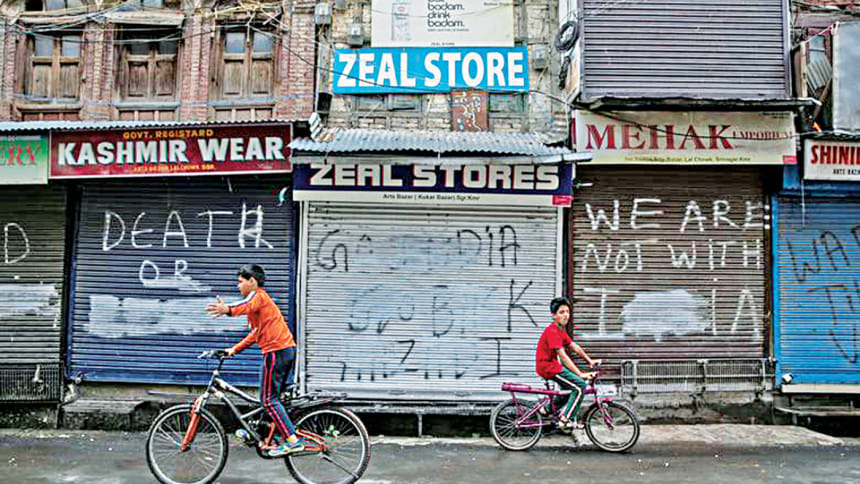Articles 370 and 35A, explained

On Monday, August 5, 2019, the people of Jammu and Kashmir lost all contact with the outside world. After clamping down on the internet and telephone lines for the 53rd time this year, deploying tens of thousands of troops in what is already one of the most militarised places on earth, shutting down all educational institutes, cancelling a major Hindu pilgrimage, evacuating tourists, arresting hundreds of local politicians and imposing Section 144—the BJP (Bharatiya Janta Party) led Government of India made historic changes to their constitutional relations with the people of Jammu and Kashmir.
Since Kashmir’s accession to the Union of India in October 1947, the Indian State has actively tried to obliterate the autonomy of the region by taking away its special privileges which were once vested to it by the Indian Constitution through Article 370 and Article 35A. The Jammu and Kashmir Reorganisation Bill, which was passed by the Lok Sabha (Lower House) and Rajya Sabha (Upper House), and the recent abrogation of Article 370, have erased the special status between Kashmir and the Indian State. Now, legally, constitutionally, and psychologically, the Indian State is oppressing 12.5 million people by depriving them of rights as basic as communication with family within and outside Kashmir, access to food and medicine, imposing curfew, alongside depriving the Kashmiris of their right to dissent, and the larger claim over their distinct legal status. This step comes with an unprecedented degradation of the state status that Jammu and Kashmir held to that of a Union Territory administered directly by the Central Government.

What are Article 370 and Article 35A? Why were they important?
Article 370, according to ex-Home Minister GL Nanda, was “the only avenue of taking the Constitution into Jammu and Kashmir”. Article 370 allowed the people of Jammu and Kashmir a certain degree of autonomy and was the cornerstone of their accession to India when formerly they had the choice of joining either India or Pakistan after their independence from British Rule in 1947.
Article 370 allowed the people of Kashmir the freedom to form their own constitution and laws. The Indian State was handed control of only the finance, defence, foreign affairs and communications for the state of Jammu and Kashmir.
At the same time, Article 35A allowed the local legislature of Jammu and Kashmir to define who the permanent residents of the region are and also forbade those not considered as permanent residents from permanently settling, purchasing immovable property, seeking employment under the state government or winning scholarships or financial aids in Jammu and Kashmir.
Both these articles guaranteed a certain degree of autonomy to the people of Jammu and Kashmir who were also promised aplebiscite by Jawaharlal Nehru.

What does the Jammu and Kashmir Reorganisation Act, 2019 say?
The Jammu and Kashmir Reorganisation Act essentially reorganises the state of Jammu and Kashmir into two Union Territories: 1. The Union Territory of Jammu and Kashmir, and 2. The Union Territory of Ladakh.
In accordance with the J&K Reorganisation Act, the Union Territory of Jammu and Kashmir will have its own Legislative Assembly consisting of 107 seats of which 24 will remain vacant for representatives from areas of Jammu and Kashmir under the control of the Pakistani Government. The Union Territory of Ladakh, on the other hand, will not have a legislative assembly. Both the newly formed Union Territories will be administered by the President of India through an administrator, appointed by the President, known as the Lieutenant Governor.
As for legislative authority, the Legislative Assembly of the UT of Jammu and Kashmir can formulate laws which are “related to: (i) any matters specified in the State List of the Constitution, except “Police” and “Public Order”, and (ii) any matter in the Concurrent List applicable to Union Territories. Further, Parliament will have the power to make laws in relation to any matter for the Union Territory of Jammu and Kashmir.”
Further, this new act repeals 153 existing state laws of Jammu and Kashmir and introduces 106 new central laws that were previously not applicable. These newly introduced central laws include the Aadhaar Act, 2016, the Indian Penal Code, 1860, etc. By rendering Article 35A ineffective, the J&K Reorganisation Act also allows for residents from all over India to purchase land in Kashmir and involve themselves in the local businesses.
All of these changes were made without the consent of the people of Kashmir.
How?
Unlike the Central government’s claims, Kashmir continues to be under siege with people, irrespective of class or other social standings, being unable to contact their family within and outside Kashmir over the telephone, internet and other means of communication.
Moreover, the process of deployment of additional ‘security’ forces which started in the latter half of July this year has intensified with reports being released claiming the number to have increased from 7,00,000 to a million.

Many scholars, jurists and historians, post the introduction of the bill in the Parliament, have claimed this step to be unconstitutional on the ground that Article 370 served as the means for Article 1 (being a part of the Indian Union) to be implemented in Kashmir. Hence, legally freeing Kashmir from the Union, a claim that the current state has been constantly trying to suppress. Alongside, what this step appears to have done is overlook the bloody past of Kashmir, be it as early as 1990s or later rejuvenations of the movement in 2008, 2009, 2010, 2013, 2016, 2018 and now in 2019.
With an unknown number of people detained, injured, and killed, the union territory of Jammu and Kashmir and particularly Kashmir stays in a limbo, making the largest democracy appear to be the Orwellian State.

 For all latest news, follow The Daily Star's Google News channel.
For all latest news, follow The Daily Star's Google News channel. 



Comments